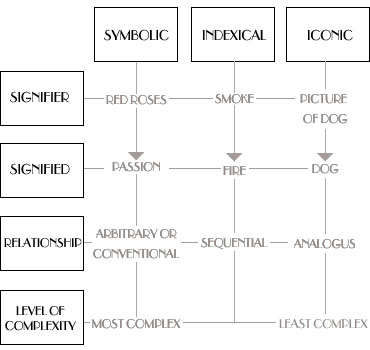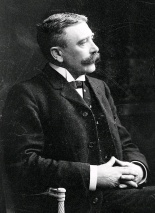Structuralism/
Post-structuralism
BACK
What is Structuralism?
Structuralism is a 20th Century intellectual movement and approach to the human
sciences that attempts to analyze a specific field as a complex system or interrelated parts. Structuralism holds that all human activity and it's products, even perception and thought itself, are constructed and not natural, and in essence everything has meaning because of the language system in which we operate. It is closely related to Semiotics (the study of signs, symbols, communication as well as how meaning in constructed and understood.
There are 4 main common ideas understanding Structuralism as a general movement:
1.) Every system has a structure
2.) The structure is what determines the position of each element of a whole
3.) Structural laws deals with coexistence rather than changes
4.) Structures are the real things that lie beneath the surface or the appearance of meaning.
Structuralism is understood to have its origins in the work of Swiss linguistic theorist Ferdinand de Saussure (1857-1913) during the 20th Century - however structuralism was soon applied to other fields such as philosophy, anthropology, sociology etc. In early 20th Century, Saussure established a science of signs based on linguistics (semiotics or semiology). He believed that any language is just a complex system of signs that express ideas, with rules which govern their usage. He called the original abstract structure of a language, langue, and the concrete manifestations or embodiments, parole. He decided that any individual sign is essentially arbitrary, and that there is no natural relationship between a signifier (e.g. the word "dog") and the signified (e.g. the mental concept of the actual animal).
What is Post-structuralism?
Post-structuralism rejects the idea of a literary text having a single purpose, a single meaning, or one singular existence. Instead, every individual reader creates a new and individual purpose, meaning, and existence for a given text. To step outside of literary theory, this position is generalizable to any situation where a subject perceives a sign. Meaning (or the signified, in Saussure's scheme, which is as heavily presumed upon in post-structuralism as in structuralism) is constructed by an individual from a signifier. This is why the signified is said to 'slide' under the signifier, and explains the talk about the "primacy of the signifier."
Post-structuralism originated in France during the 1960s as an antinomian movement critiquing structuralism. Two key figures in the early post-structuralist movement were Jacques Derrida and Roland Barthes. In a 1966 lecture "Structure, Sign and Play in the Discourse of the Human Sciences", Jacques Derrida presented a thesis on an apparent rupture in intellectual life. Derrida interpreted this event as a "decentering" of the former intellectual cosmos. Instead of progress or divergence from an identified centre, Derrida described this "event" as a kind of "play."
Although Barthes was originally a structuralist, during the 1960s he increasingly favored post-structuralist views. In 1967, Barthes published “The Death of the Author” in which he announced a metaphorical event: the "death" of the author as an authentic source of meaning for a given text. Barthes argued that any literary text has multiple meanings, and that the author was not the prime source of the work's semantic content. The "Death of the Author," Barthes maintained, was the "Birth of the Reader," as the source of the proliferation of meanings of the text.
Structuralism vs. Post-structuralism
Structuralism was an intellectual movement in France during the 1950s and 1960s that studied the original structures in cultural products (such as texts) and used analytical concepts from linguistics, psychology, anthropology and other fields to interpret those structures. It highlighted the logical and scientific nature of its results.
Post-structuralism offers a study of how knowledge is produced and a critique of structuralist ideas. It argues that because history and culture condition the study of underlying structures it is subject to biases and misinterpretations. To understand an object (e.g. one of the many meanings of a text), a post-structuralist approach argues, it is necessary to study both the object itself and the systems of knowledge that produced the object.
Post-structuralists generally assert that post-structuralism is historical, and classify structuralism as descriptive. This terminology relates to Ferdinand de Saussure's distinction between the views of historical and descriptive reading. From this basic distinction, post-structuralist studies often emphasize history to analyze descriptive concepts.
Structuralists also seek to understand the historical interpretation of cultural concepts, but focus their efforts on understanding how those concepts were understood by the author in his or her own time, rather than how they may be understood by the reader in the present.
The uncertain distance between structuralism and post-structuralism is further blurred by the fact that scholars generally do not label themselves as post-structuralists. In some cases (e.g. Roland Barthes), scholars associated with structuralism became noteworthy in post-structuralism as well. Three of the most prominent post-structuralists were first counted among the so-called "Gang of Four" of structuralism par excellence: Jacques Lacan, Roland Barthes, and Michel Foucault. The works of Jacques Derrida, Gilles Deleuze, and Julia Kristeva are also counted as prominent examples of post-structuralism.


Ferdinand de Saussure
(1857-1913)
Jacques Derrida
(1930-2004)
Roland Barthes
(1915-1980)
Michel Foucault
(1926-1984)
References
Click to view websites